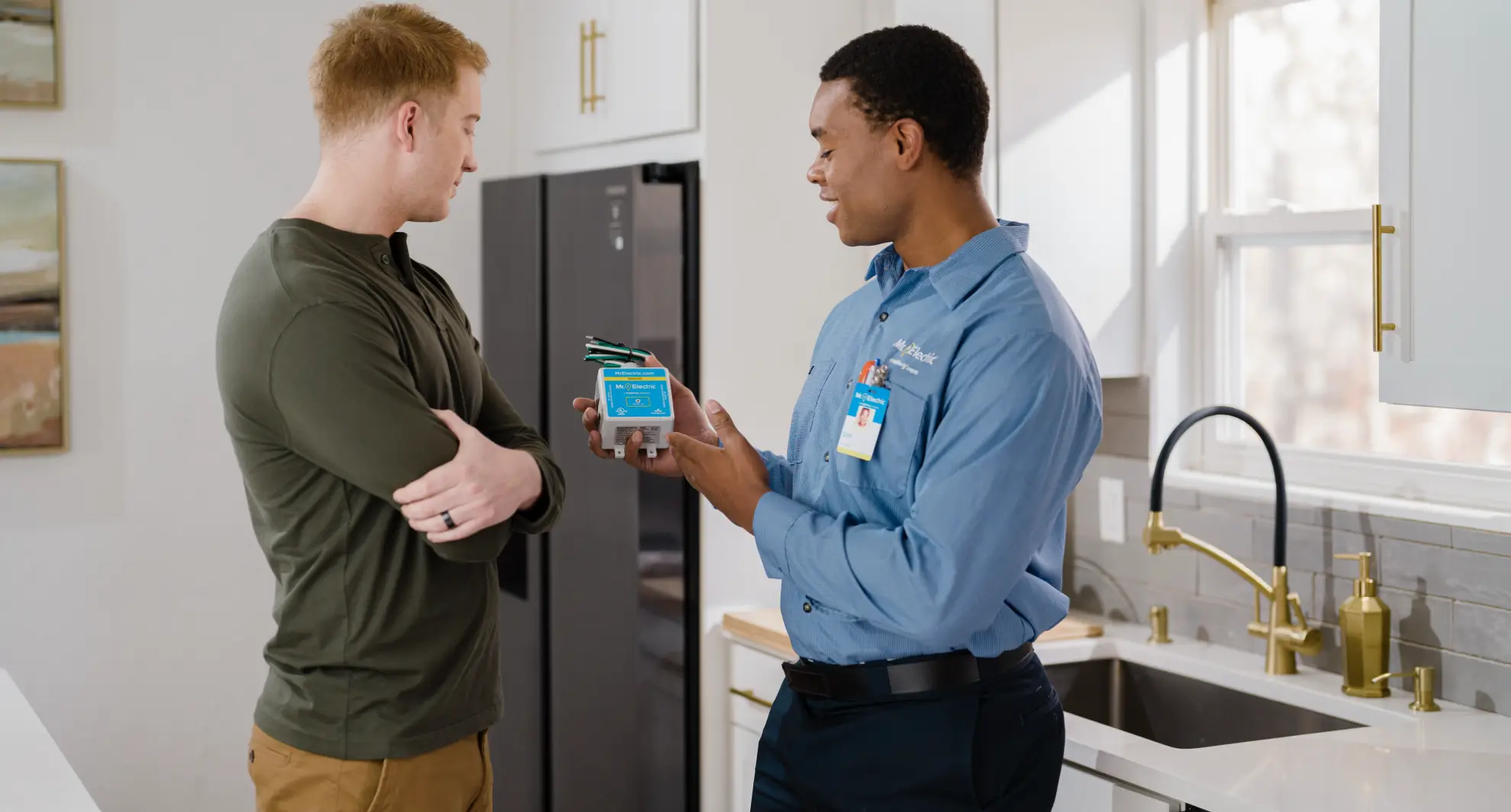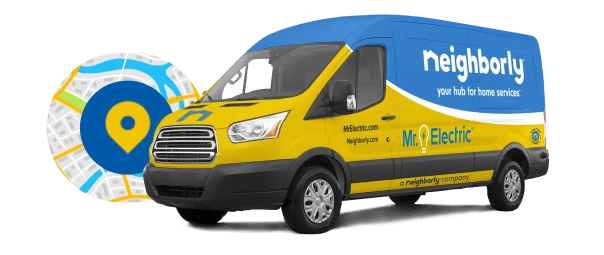
Power surges don't always announce themselves with a flash of lightning. They can come from downed lines, faulty appliances, and fluctuations in your utility service, silently putting your electronics, appliances, and entire electrical system at risk. A whole-house surge protector offers a smart layer of defense, but it's not a DIY job. In this article, we'll explain why professional whole-house surge protector installation matters and how it helps keep your home protected long-term.
What Is a Whole-House Surge Protector?
A whole-house surge protector is connected directly into your home's electrical panel to help prevent voltage spikes from damaging your appliances, devices, and electrical systems. Unlike plug-in surge strips that protect a single outlet, a whole-home surge protector offers a first line of defense at the panel level, before excess voltage ever reaches your wiring.
How it works
Whole-house surge protectors constantly monitor the electrical flow coming into your home. When a surge is detected, the device redirects that excess energy safely into the ground. The result? Your sensitive electronics and expensive appliances stay protected from the power spike that can damage them in an instant.
Shield your home's entire electrical system, including HVAC units, refrigerators, wall-mounted TVs, built-in lighting, and more with whole-house surge protectors. It's a quiet kind of protection that works behind the scenes but makes a big difference when it counts.
How does it work?
Whole-house surge protectors continuously monitor the flow of electricity coming into your home. When a surge is detected, they immediately divert excess voltage safely into the ground to help prevent costly damage to sensitive devices and major systems.
Why Surge Protection Matters
Surge protection is essential for keeping your home’s electronics and appliances safe from unexpected voltage spikes. Power surges happen more often than most people realize. Some are large and noticeable, like those caused by lightning strikes. Others are smaller and occur inside the home when appliances like refrigerators or HVAC systems power on and off.
Over time, these surges put consistent stress on your electrical system. Without a whole-house surge protector, even minor surges can reduce the lifespan of your devices or destroy them without warning.
Common sources of power surges include:
- Lightning strikes: Even a strike miles away can send a spike through utility lines into your home's electrical system.
- Utility grid issues: Power outages, maintenance, and fluctuations from the grid can cause sudden voltage shifts that damage home circuits.
- Large appliance cycling: Equipment like HVAC systems, refrigerators, and washers naturally draw and release power, sending small surges through the wiring.
The hidden costs of ignoring surge protection
Most people think about TVs, computers, and gaming systems when they hear "power surge," and those are at risk. But the reality goes deeper. Surge damage can also fry critical components inside your furnace, refrigerator, or air conditioning system, leading to needed repairs or replacements that cost far more than installing protection upfront.
Safeguarding your home with professional whole-house surge protection is one of the simplest ways to shield your electronics.
Why Whole-House Surge Protector Installation Isn't DIY-Friendly
Installing a whole-house surge protector requires working directly inside your main electrical panel, which involves handling high-voltage wiring and live circuits. Unlike plugging in a surge strip, whole-house surge protection installation is a job that demands an electrician who understands your home's electrical layout, can safely integrate the device with your breaker system, and ensure it meets electrical and municipal code requirements.
The risks of DIY installation include:
- High-voltage exposure: The main service panel brings in power directly from the utility company. Even with the breakers off, the incoming lines remain live and can pose dangers to those without proper training.
- Improper connections: A single misstep when connecting the surge protector to your panel can result in poor performance, panel damage, or even a failed device that won't protect anything.
- No backup plan: Without the proper tools, safety gear, or experience, a DIY install leaves no margin for error, leaving you exposed.
- Code and insurance concerns: Surge protector installation needs to comply with your local building and national electrical code. If a DIY install causes damage or doesn't meet standards, you could be dealing with denied insurance claims or required rework.
Bottom line: call an electrician
Knowing where to mount the device, how to route the wiring, which breaker slots to use, and how to test and deploy a whole-house surge protector all require training and experience. An electrician brings both to the job, along with the confidence that everything will be wired, tested, and ready to protect.
Mr. Electric® makes whole-house surge protector installation simple, safe, and code-compliant, so your protection starts the second we flip the power back on.

How an Electrician Installs a Whole-House Surge Protector
Installing a whole-house surge protector is a detailed process that demands precision, training, and the right tools. Here's what an electrician does to make sure everything is done safely, correctly, and to code:
Step 1: Power down safely
Before installation begins, the electrician shuts off the main breaker to cut power to the home's circuits. But it's important to remember: the service lines feeding into the panel are still energized and dangerous, which is why experience matters from the start.
Step 2: Remove the panel cover
Next, the trained service professional removes the panel cover to access the circuit breakers and wiring. Then, the service professional inspects the panel's layout to determine the best mounting location for the surge protector without disrupting the existing system.
Step 3: Mount the surge protector
Depending on the model, the electrician mounts the surge protector either inside the panel or on the wall nearby. As with all electrical work, proper placement is essential. Many manufacturers specify that wire runs must be kept as short and straight as possible for the device to work properly.
Step 4: Connect the wiring
The electrician cuts, strips, and connects the wires from the surge protector to the correct points inside the panel. Typically, the black and red wires connect to a dedicated double-pole breaker, the green wire attaches to the ground, and the white wire connects to the neutral bus bar.
This step must be done precisely to ensure the device will react properly during a surge.
Step 5: Verify grounding
Proper grounding is essential for surge protection to work. If the panel's ground system isn't sufficient, the electrician will make the necessary corrections to ensure safe, reliable energy diversion during a surge event.
Step 6: Reassemble, restore power, and test
Once everything is connected and secured, we replace the panel cover, restore the main power, and test the surge protector to confirm proper operation. The system isn't considered complete until the electrician verifies that the device is functioning and ready to shield your home from incoming surges.
The Benefits of Professional Whole-House Surge Protector Installation
When you trust Mr. Electric with your whole-house surge protector installation, you get complete peace of mind. Our trained and experienced service professionals know how to do the job safely, efficiently, and correctly, without cutting corners. Here's what you can expect:
Expert installation done right
We don't guess. We evaluate your electrical panel, match you with the right surge protector, and install it according to strict manufacturer guidelines, local regulations, and the National Electrical Code.
Protection that works when you need it
A properly installed surge protector doesn't just sit quietly; it reacts instantly when a surge hits. Our team makes sure your system is wired to respond exactly when it matters most.
No surprises, no risk
DIY installs come with hidden dangers and guesswork. Our professional service eliminates that uncertainty and helps you avoid potential system damage, insurance issues, and costly rework.
Backed by the Neighborly Done Right Promise
We back every installation with the Neighborly Done Right Promise®, which ensures you'll be happy with our work.
Protect Your Home from the Unexpected—Schedule with Mr. Electric
Power surges don't wait for the right time to hit. Get ahead of the damage with professionally installed surge protection from your local Mr. Electric. Our service professionals handle everything safely and efficiently. Request your whole-house surge protector installation today and safeguard everything that keeps your home running.
This article is intended for general guidance only and is not applicable to every situation. You are responsible for determining the proper course of action for your property and situation. Mr. Electric is not responsible for any damages that occur as a result of advice and/or guidance derived from its blog content.
Some Mr. Electric services vary by location. Contact your local Mr. Electric franchise for more information.
FAQs About Whole-House Surge Protectors
The safety of you, your family, and home are the top priority of every Mr. Electric service professional. Our safety-first commitment to solving your electrical issues includes a meticulous attention to detail on every job. Our commitment also includes using our years of experience to answer your questions. Below are answers to some of the most frequently asked questions about whole-house surge protectors.
How long does a whole-house surge protector last?
Most whole-house surge protectors last between five and 10 years, depending on the model and how often they're hit with surges. Your electrician can recommend when to check or replace it.
Does a whole-house surge protector protect everything in my home?
It protects major appliances, hardwired systems, and anything plugged into your home's electrical circuits. For layered protection, sensitive electronics should still be plugged into high-quality surge power strips.
Will a surge protector stop power outages?
No. Surge protectors guard against voltage spikes; they don't prevent outages. However, they do shield your system from the damaging surges that can follow when power is restored.
Do I need a surge protector if I have a backup generator?
Yes. Power fluctuations can happen during generator startup and shutdown. A whole-house surge protector helps smooth out transitions and protects your home during those critical moments.

